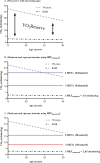Need to Revise Classification of Physical Activity Intensity in Older Adults? The Use of Estimated METs, Measured METs, and V̇O2 Reserve
- PMID: 38703071
- PMCID: PMC11215700
- DOI: 10.1093/gerona/glae120
Need to Revise Classification of Physical Activity Intensity in Older Adults? The Use of Estimated METs, Measured METs, and V̇O2 Reserve
Abstract
Background: Multiples of resting metabolic rate (RMR) are often used to classify physical activity intensity, a concept known as the metabolic equivalent of task (MET). However, the METs metrics may misclassify physical activity intensity in older adults because of age-related changes in RMR and maximal aerobic capacity (V˙O2max). This study aimed to (i) compare classifications of activity intensity by estimated (METsestimated) and measured (METsmeasured) METs and (ii) compare physical activity classified by absolute (METsmeasured) versus relative intensity (%V˙O2Reserve) in older adults.
Methods: Ninety-eight adults aged 75-90 years participated in the study. RMR and V˙O2 during sitting, standing, daily activities, and 6-minute walking test were measured. V˙O2Reserve was defined as the difference between V˙O2max and RMR. Moderate and vigorous intensity was classified as 3 and 6 METs and 40% and 60% of V˙O2Reserve, respectively. Paired t tests and a confusion matrix were used to investigate aims 1 and 2, respectively.
Results: METsmeasured was 24% lower than the standard 1 MET of 3.5 mL O2·min-1·kg-1. METsestimated underestimated the intensity during daily and walking activities when compared to METsmeasured. Nevertheless, when comparing METsmeasured to percentages of V˙O2Reserve, a mismatch was shown for moderate intensity in 47%-67% of the participants during daily activities and 21% of the participants during self-selected gait speed.
Conclusions: Applying METsestimated for older adults leads to potential underestimation of physical activity intensity, suggesting that current classification metrics should be revised for older adults. V˙O2Reserve is a candidate metric for establishing precise physical activity intensity cut points for older adults. Clinical Trials Registration Number: NCT04821713.
Keywords: Aerobic reserve capacity; Daily activities; Energy expenditure; Maximum oxygen uptake; Resting metabolic rate.
© The Author(s) 2024. Published by Oxford University Press on behalf of The Gerontological Society of America. All rights reserved. For commercial re-use, please contact reprints@oup.com for reprints and translation rights for reprints. All other permissions can be obtained through our RightsLink service via the Permissions link on the article page on our site—for further information please contact journals.permissions@oup.com.
Conflict of interest statement
The authors have no conflict of interest to declare and do not have a professional relationship with companies or manufacturers who would potentially benefit from the results of the present study. The result of the study is presented honestly and transparent without any fabrication, falsification, and inappropriate manipulation of data.
Figures



Similar articles
-
Moderate and Vigorous Physical Activity Intensity Cut-Points for Hip-, Wrist-, Thigh-, and Lower Back Worn Accelerometer in Very Old Adults.Scand J Med Sci Sports. 2025 Jan;35(1):e70009. doi: 10.1111/sms.70009. Scand J Med Sci Sports. 2025. PMID: 39753998 Free PMC article.
-
Exercise for acutely hospitalised older medical patients.Cochrane Database Syst Rev. 2022 Nov 10;11(11):CD005955. doi: 10.1002/14651858.CD005955.pub3. Cochrane Database Syst Rev. 2022. PMID: 36355032 Free PMC article.
-
Pulmonary rehabilitation versus usual care for adults with asthma.Cochrane Database Syst Rev. 2022 Aug 22;8(8):CD013485. doi: 10.1002/14651858.CD013485.pub2. Cochrane Database Syst Rev. 2022. PMID: 35993916 Free PMC article.
-
Aerobic exercise training for adults with fibromyalgia.Cochrane Database Syst Rev. 2017 Jun 21;6(6):CD012700. doi: 10.1002/14651858.CD012700. Cochrane Database Syst Rev. 2017. PMID: 28636204 Free PMC article.
-
Cephalomedullary nails versus extramedullary implants for extracapsular hip fractures in older adults.Cochrane Database Syst Rev. 2022 Jan 26;1(1):CD000093. doi: 10.1002/14651858.CD000093.pub6. Cochrane Database Syst Rev. 2022. PMID: 35080771 Free PMC article.
Cited by
-
Device-based measurement of physical activity and sedentary behaviour after critical illness: A scoping review.PLoS One. 2025 Jun 3;20(6):e0322339. doi: 10.1371/journal.pone.0322339. eCollection 2025. PLoS One. 2025. PMID: 40460111 Free PMC article.
-
Moderate and Vigorous Physical Activity Intensity Cut-Points for Hip-, Wrist-, Thigh-, and Lower Back Worn Accelerometer in Very Old Adults.Scand J Med Sci Sports. 2025 Jan;35(1):e70009. doi: 10.1111/sms.70009. Scand J Med Sci Sports. 2025. PMID: 39753998 Free PMC article.
-
Association of cardiorespiratory fitness with HR-pQCT bone parameters in older adults: the Study of Muscle, Mobility and Aging (SOMMA).Osteoporos Int. 2025 Aug;36(8):1469-1480. doi: 10.1007/s00198-025-07485-2. Epub 2025 Jun 12. Osteoporos Int. 2025. PMID: 40504257
References
Publication types
MeSH terms
Associated data
Grants and funding
LinkOut - more resources
Full Text Sources
Medical
Miscellaneous

